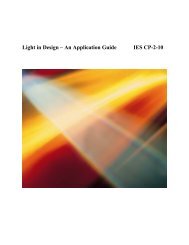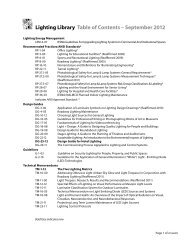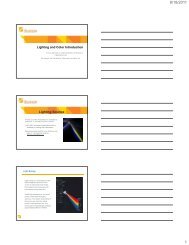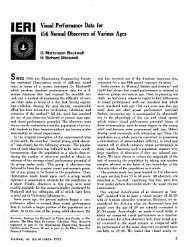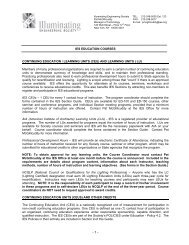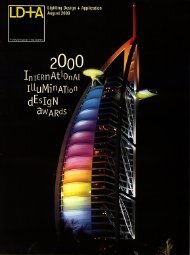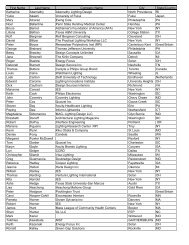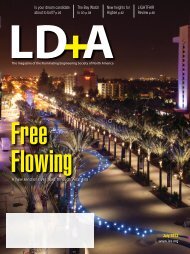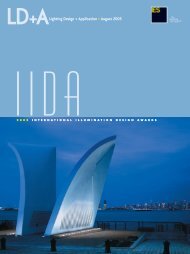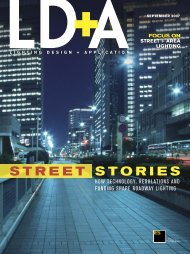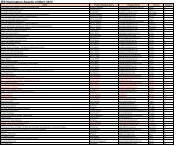light products - Illuminating Engineering Society
light products - Illuminating Engineering Society
light products - Illuminating Engineering Society
Create successful ePaper yourself
Turn your PDF publications into a flip-book with our unique Google optimized e-Paper software.
INDUSTRY UPDATES<br />
Three LED, SSL Joint<br />
Ventures Announced<br />
Lighting Services Inc (LSI), a manufacturer<br />
of track, accent, display, fiber<br />
optic, and now, solid-state <strong>light</strong>ing<br />
(SSL) systems has formed a strategic<br />
partnership with TIR Systems Ltd.,<br />
the developer of the SSL product, the<br />
LEXEL. With a large share of museum,<br />
gallery and high-end retail <strong>light</strong>ing<br />
markets, LSI says the partnership will<br />
enable the two companies to develop<br />
a range of LEXEL-based fixtures that<br />
produce white <strong>light</strong> with a full range<br />
of color temperatures.<br />
TIR also signed a design collaboration<br />
agreement with the Genlyte<br />
Group to develop and market LEXELbased<br />
<strong>products</strong> under the Lightolier<br />
and Canlyte brands. The focus of this<br />
design collaboration will be on developing<br />
<strong>products</strong> for the retail, restaurant,<br />
commercial and residential markets.<br />
Meanwhile, Color Kinetics Inc. and<br />
Litecontrol Corp. announced an agreement<br />
that will apply Color Kinetics<br />
technology to a LED-based product<br />
line offered by Litecontrol. Consisting<br />
of three offerings, the line will be based<br />
on versatile Digital Light Engines<br />
(DLEs), which apply Chromacore technology<br />
to efficiently generate colored<br />
<strong>light</strong> and color-changing effects. They<br />
will also be compatible with Color<br />
Kinetics’ line of intuitive controllers,<br />
providing an integrated system for<br />
diverse applications, from wall washing<br />
to cove and accent <strong>light</strong>ing.<br />
Growth is Good<br />
In 2004, the Imperial Palace Hotel (formerly the Amiga) in Seoul,<br />
South Korea, was expanded to nearly three times its size, while the<br />
amount of hotel rooms doubled to 430. Re-opened in 2005, the additions<br />
included a convention center, nine restaurants, a spa and a shopping<br />
center.To maintain its meticulous ambiance and flexible buildingwide<br />
control, the hotel uses an ETC Unison architectural <strong>light</strong>ing system,<br />
which consists of sensor dimmers and theatrical fixtures. Pictured<br />
is the Imperial Palace lobby.<br />
LRC Selected by FAA To Study Airport Lighting<br />
The Lighting Research Center (LRC) at Rensselaer Polytechnic Institute,Troy, NY, was selected by the Federal Aviation<br />
Administration (FAA) to join its Centers of Excellence program.The LRC will conduct <strong>light</strong>ing research as part of the<br />
Center of Excellence for Airport Technology (CEAT), which focuses on airport structures, pavement materials, wildlife<br />
issues, anti-icing and <strong>light</strong>ing. Specifically, the LRC will focus on the area of solid-state <strong>light</strong>ing and vision science.<br />
The LRC will explore the potential performance and application of new <strong>light</strong> source technologies, primarily LEDs, in<br />
airport and airfield <strong>light</strong>ing.The LRC will look at how these new technologies can be applied to <strong>light</strong> runways, taxiways,<br />
approaches and other areas of the airfield.<br />
For its first project with CEAT, the LRC will develop recommendations and metrics that consider the brightness perception<br />
of LED <strong>light</strong>ing on the airfield.“Performance standards for LED systems based on traditional <strong>light</strong>ing metrics, like<br />
luminance, are causing problems for viewers,” said LRC director of research, Nadarajah Narendran. As an example, he<br />
says a green LED approach <strong>light</strong> is typically perceived as much brighter and less comfortable to view than an incandescent<br />
green <strong>light</strong> of the same luminance.“A better metric is needed so that LED systems can be produced and used in<br />
the field without causing discomfort to pilots,” he said.<br />
The LRC will also work with the FAA to conduct psychophysical studies that compare the brightness perception of<br />
colored and white LED <strong>light</strong>ing systems with incandescent <strong>light</strong>ing systems, which use filters to create colored <strong>light</strong>.<br />
December 2005 LD+A 25



